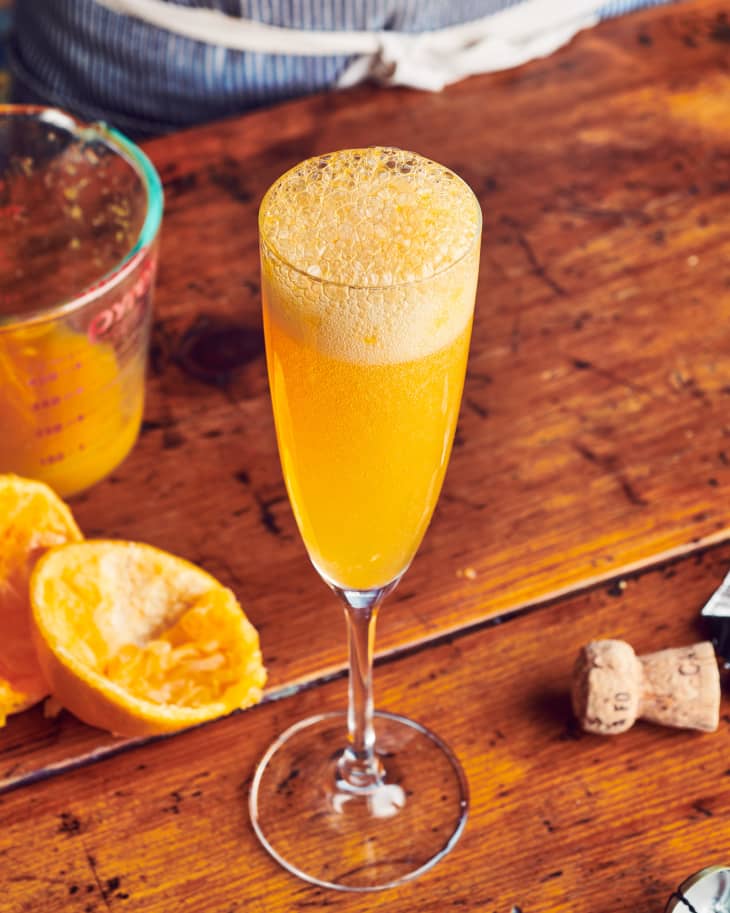How To Make the Perfect Mimosa

A few simple steps result in the ultimate version of this brunch classic.
Serves1
Prep3 minutes
There’s nothing like a good mimosa. The classic cocktail, made with equal parts sparkling wine and juice, is refreshing and beautiful in color, and is best enjoyed when it’s very cold. The combination of citrus and crisp grapes allows you to get both sweet and sharp sips, and makes for the perfect boost for any occasion. Here, I’ll show you how to craft the perfect one, from selecting the best ingredients to serving it in style.
The History of the Mimosa
Like most cocktails, the mimosa has many creation stories. The first documented cocktail with citrus juice (orange juice) was the Buck’s Fizz, which is said to have been created in 1921 by Pat McGarry, the first bartender at the Buck’s Club in London, England. It’s then believed that in 1925, a bartender named Frank Meier invented the mimosa at the Ritz Hotel in Paris. But there’s also a story that says director Alfred Hitchcock invented the mimosa in San Francisco in the 1940s.
Regardless of the exact details, we do know that the mimosa is named after the yellow-flowered mimosa plant, Acacia dealbata. Its flower is often taken as a sign of joy, and grows beautifully in the winter. Its name is derived from the Greek “mimos,” which means “actor” or “mime,” while the suffix means “resembling.” This is said because the leaves are thought to mimic conscious life.
The Best Sparkling Wine for Mimosas
We also know the mimosa had bubbles, and any sparkling wine — such as Champagne, Cava, or Prosecco — can all be used. As for which to choose, know that Cava and Champagne both have a bitterness that adds dry, crisp sips without all the sugar, and that Champagne has more alcohol content than Prosecco. I personally prefer Cava because it’s so sharp and crisp.
If you opt for Champagne, I recommend Laurent-Perrier. As for cava, try a bottle of Freixenet.
The Best Citrus Juice for Mimosas
While orange juice is the most common choice and readily available, the tangerine is just as ready to be juiced for joy. Tangerine juice offers a brighter color, has a richer, sweeter flavor, and takes this simple cocktail up a notch.
Regardless of the citrus fruit you choose, it’s important to keep it cold. Keep your oranges or tangerines chilled until you’re ready to juice them, and return the freshly-squeezed juice to the refrigerator while you open the sparkling wine. If you’d like to remove the pulp, pour the juice through a fine-mesh strainer before refrigerating.
Serving Your Mimosa
Depending on where you live, a mimosa can be served in a Champagne glass or classic coupe. I personally prefer a Champagne flute, which holds six ounces of joy and has a stem that allows you to carefully hold it so it doesn’t get warm from your hands. Garnish with a bitter fruit like pomegranate or blackberries and you have a rollercoaster of flavors ranging from juicy, tart, crisp and bitter. Something to celebrate for sure.
How to Make the Perfect Mimosa
A few simple steps result in the ultimate version of this brunch classic.
Prep time 3 minutes
Serves 1
Nutritional Info
Ingredients
- 2
cold medium tangerines or oranges
- 2 1/2 ounces
chilled sparkling wine, such as Laurent-Perrier Champagne or Freixenet Cava
Garnish options: pomegranate seeds, blackberries, or raspberries
Equipment
6-ounce champagne flute
Knife and cutting board
Cocktail measure
Juicer
Fine-mesh strainer and glass or measuring cup with spout (optional)
Instructions
Juice and chill the citrus. Halve and juice 2 cold medium tangerines or oranges. If you’d like to remove the pulp, pour the juice through a fine-mesh strainer into a glass or measuring cup with a spout. Place the juice and a 6-ounce champagne flute in the refrigerator.
Open the sparkling wine. Open the sparkling wine if needed: Using a napkin or towel, untwist the cage counterclockwise, putting pressure on the cork to keep it from popping out prematurely. Twist the bottle—not the cork. Once the bottle starts to loosen from the cork and is able to spin freely, begin to slowly pull the cork away from the bottle. The pressure of the bottle will loosen the cork out, you can control how quickly the cork separates itself from the bottle. Release slowly at a 45-degree angle to allow air to get out and not cause an eruption.
Pour the juice. Pour 2 1/2 ounces of the juice into the champagne glass.
Add the sparkling wine. Fill the rest of the glass with the sparkling wine.
Garnish if desired. Garnish the mimosa with pomegranate seeds, raspberries, or blackberries if desired.
